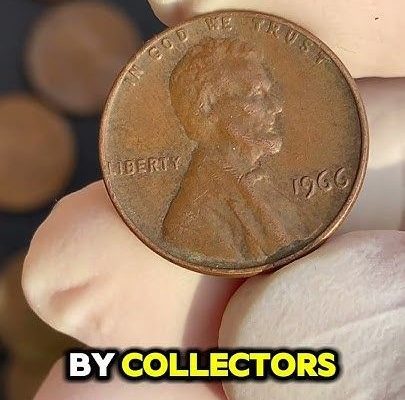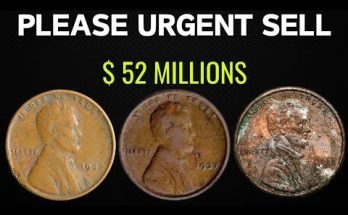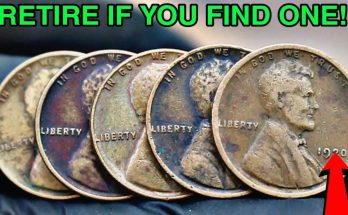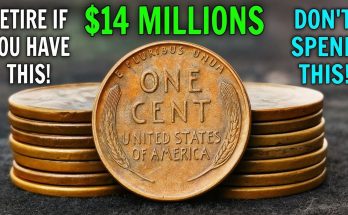MOST EXPENSIVE AND RARE LINCOLN PENNY YOU SHOULD LOOK FOR | MOST VALUABLE PENNIES
The Ultimate Guide to Finding the Most Valuable Lincoln Pennies
Could a small, unassuming coin in your pocket be worth a life-changing amount of money? For decades, the Lincoln penny has been the most common coin in American circulation, but hidden among the billions of cents minted over the last century are a select few that are so rare and valuable they’ve sold for six or even seven figures at auction. This is your ultimate guide to the most expensive and sought-after Lincoln pennies, detailing exactly what to look for and why these numismatic treasures command such incredible prices. Prepare to look at your spare change in a whole new way, because the next time you find a penny, you might just be holding a fortune.
The king of all error coins is undoubtedly the 1943 Copper Lincoln Cent. This coin is a legend in the numismatic world and for good reason. During World War II, the U.S. Mint needed copper for the war effort, so in 1943, all pennies were supposed to be struck on zinc-coated steel planchets, giving them a distinct silvery appearance. However, a small number of bronze planchets from 1942 were accidentally left in the presses at the Philadelphia, Denver, and San Francisco mints. These few dozen coins were mistakenly struck and released into circulation. With an estimated 10 to 20 known examples, the 1943 Copper Penny is a monumental rarity. The most valuable example, a 1943-D, sold for an astonishing $1.7 million. If you find a penny dated 1943 that looks coppery-brown, the first thing to do is a simple magnet test. If it sticks to a magnet, it’s the common steel version. If it doesn’t, you may have just found the holy grail of coin collecting.
Beyond the 1943 copper, other pennies have achieved legendary status due to dramatic mint errors. The 1969-S Doubled Die Obverse is one such coin, famous for its incredibly strong doubling. The mistake is so pronounced that “LIBERTY” and “IN GOD WE TRUST” appear as clear, ghostly double images, visible to the naked eye. This error was caught early, and most of the coins were supposedly destroyed, but a small handful escaped. With a value that can reach into the low six figures, this is a coin every collector dreams of finding. Similarly, the 1955 Doubled Die Obverse is another iconic error. Though not as rare as the 1969-S, its dramatic doubling on the date and motto has made it a classic for generations. Many were released into circulation and are still found today, making it a viable (if extremely lucky) find for the diligent penny hunter.
While error coins often steal the spotlight, some of the most valuable Lincoln cents are simply “key dates” with low mintages. The 1909-S VDB is the most famous of these. Struck in the first year of the Lincoln cent’s release, this coin features the initials of its designer, Victor David Brenner, prominently on the reverse. Public outcry led to the removal of the initials shortly after, making the initial run incredibly scarce. The San Francisco mint version, with a low mintage of just 484,000, is a highly coveted coin that can be worth thousands of dollars. Another significant key date is the 1914-D, which had an exceptionally low mintage of just over one million. A well-preserved example can sell for over $100,000, making it one of the most valuable non-error coins in the series.
When hunting for rare pennies, you must also be aware of common misconceptions and specific error types. For example, a 1966 Lincoln penny with “no mint mark” is not an error; the Philadelphia Mint did not use mint marks on cents from 1965 to 1967. True errors to look for include:
- Doubled Die: As mentioned, this is a misalignment of the die strike.
- Off-Center Strike: The coin is struck with the planchet off-center, leaving part of the design missing and a blank curved area.
- Clipped Planchet: A piece of the coin’s edge is missing in a curved or straight line, a result of a manufacturing error.
- Transitional Errors: Like the 1943 Copper and 1944 Steel, these coins were struck on the wrong metal planchet during a change in composition.
The pursuit of these rare and valuable coins is a thrilling hobby. The next time you receive a handful of change, take a moment to inspect each penny. Check the date, look for doubling, and keep an eye out for any anomalies. A thorough search could lead to a discovery that connects you to history and rewards you with a significant payday. But remember, if you believe you have found a valuable coin, do not attempt to clean it. Cleaning can drastically reduce its value. Instead, preserve its condition and consult a professional numismatist or a reputable grading service to authenticate your find. Happy hunting!



